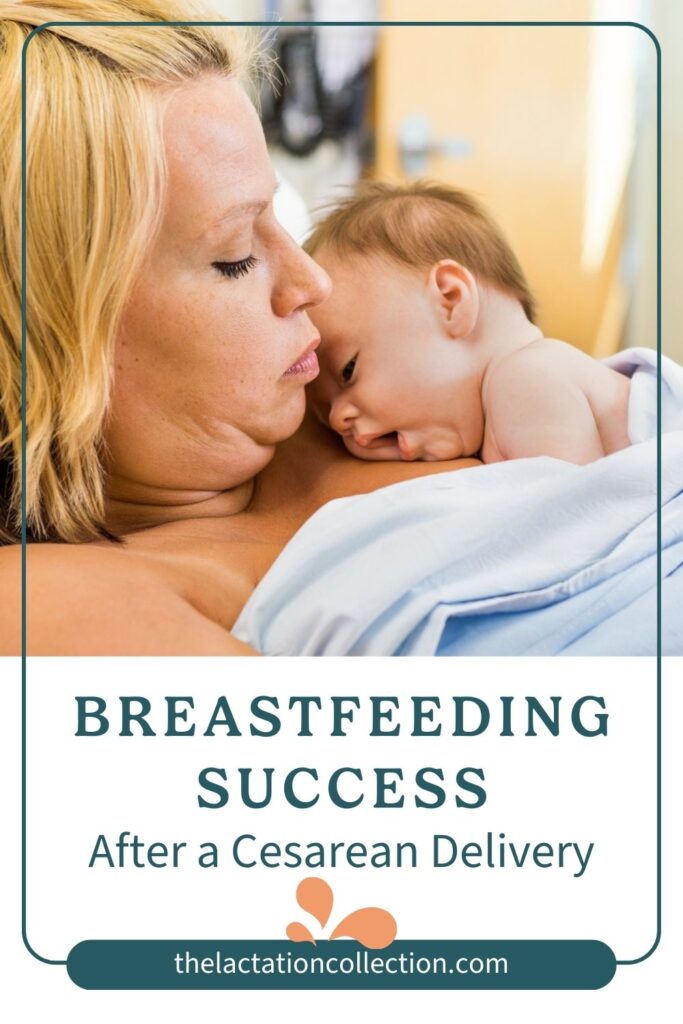The C-section rate in the United States is 31%. That means nearly a third of births are completed through C-sections. We need to better support C-section mamas!
Now, some birth interventions have been found to lead to breastfeeding difficulties. Women who deliver via planned Cesarean Section are less likely to be breastfeeding beyond the 12-week mark compared to those who deliver vaginally. However, this doesn’t mean that these mamas are incapable of having a long and successful breastfeeding experience.
Whether you are planning to have a C-section or want to be prepared “just in case,” here are 5 tips to help you have breastfeeding success after a C-section.

5 Tips for breastfeeding success after a c-section
Prepare for breastfeeding
There are plenty of ways to prepare for breastfeeding. You don’t have to start breastfeeding naively. Read up on multiple reputable websites on how you can prepare. We wrote 6 Ways to Prepare for Breastfeeding Before Having Your Baby to help you get started. Do your research for both vaginal and c-section deliveries. Understanding how both forms of delivery can impact your breastmilk production will help you be prepared for any circumstance.
You can also take a breastfeeding class. We offer both online and in-person classes. If you’re not near Utah Valley and don’t want an online course, I recommend asking your birth provider what local courses he or she recommends. A class can help ready you and build confidence in yourself and your abilities before baby arrives.
Don’t Skip the “Golden Hour”
If all is well with you and baby, there is no reason to skip immediate skin-to-skin contact. The hour-long (plus) of continuous skin-to-skin contact following birth is called the “Golden Hour.” Participating in this skin-to-skin contact promotes bonding and milk supply. With a C-section, you absolutely still can have the “golden hour,” you just need to be sure to request it. If for some reason it needs to be delayed, begin that hour as soon as possible.
When babies are left on the mother’s chest, undisturbed for two-plus hours, babies will typically latch and successfully breastfeed with little to no help. Skin-to-skin contact will also reduce stress in both baby and mom. The skin-to-skin contact cues hormone releases, which stabilizes vitals, such as blood sugar, temperature, breathing rate, and heart rate for mom and baby.

Breastfeed Early and Often
Sometimes the medications used during a C-section can cause baby to be sleepy. The best thing you can do is to feed baby frequently when baby is awake. Feeding baby at least every 2-3 hours (be sure to wake baby to eat if they sleep longer than that—at least for the first two weeks) will help your body know that it’s time to start producing milk.
Try different positions
You’ll likely feel relatively uncomfortable in your abdominal area, and understandably so! I recommend trying different breastfeeding positions to find what is most comfortable for you. The football hold is a good option not to put pressure on your abdomen. Read up on the most common breastfeeding positions.

Support is Key
Having people around you who support your decision to breastfeed improves breastfeeding outcomes. Communicate your desires to your partner, family, friends, and providers. Doing so will show your seriousness in this desire. If your support system is unsure how to support you, suggest having them attend a breastfeeding course with you or read up on how to best help you.
It’s also beneficial to have an IBCLC selected before your birth. This way, your IBCLC can meet you at your home or hospital following your delivery to help get you started. Lucky for you, you know a group of IBCLCs!








